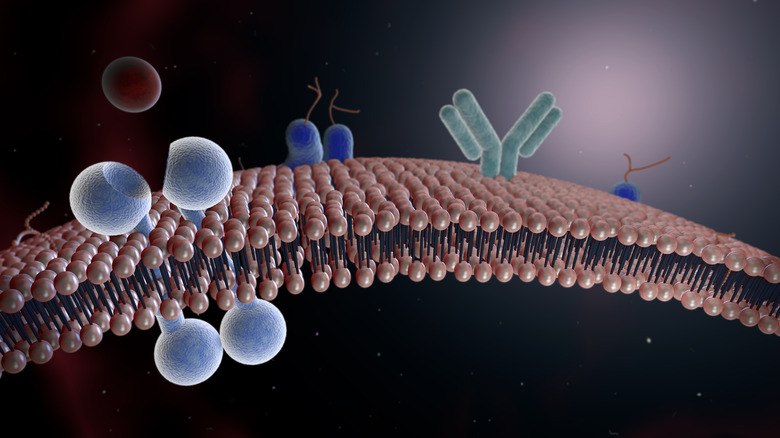Where Are Lipids Located In The Body?
Lipids are an important part of the body, along with proteins, sugars, and minerals. They can be found in many parts of a human: cell membranes, cholesterol, blood cells, and in the brain, to name a few ways the body uses them. Lipids are important for cell membrane structure, regulating metabolism and reproduction, the stress response, brain function, and nutrition. Although excess fat in the diet can lead to obesity, lack of lipids in the diet can lead to serious problems, including blood clotting, bone structure, and eyesight problems when fat-soluble vitamins are not present in the diet.
Cell Membranes
Cell Membranes
The cell membrane is comprised of two layers of lipid: phospholipids and glycolipids, with a hydrophilic (water-loving) head group and hydrophobic (water-hating) fatty acid tails that are 14 to 24 carbon atoms long. The long hydrophobic fatty acid tails of phospholipids and glycolipids clump together in the interior of the membrane and the hydrophilic head groups line the inner and outer sides of the membrane. The membrane separates the inside of the cell from the outside, and most molecules require a specific protein to help it cross the membrane.
Hormones
Hormones
Cholesterol is a very common lipid in the body and has 27 carbon atoms linked together in rings, rather than having long chain fatty acids. Except for a hydrophilic alcohol group on cholesterol, the entire molecule is hydrophobic, and most of the cholesterol molecule is in the center of the membrane. Cholesterol is modified into corticosteroids in the adrenal glands. Glucocorticoids regulate the metabolism of sugars and the stress response. Mineralocorticoids regulate the salt and water balance in the body. Cholesterol is also made into androgens, like testosterone, and estrogens, which regulate reproduction and secondary sexual characteristics (that make males look masculine and females look feminine).
Fat-Soluble Vitamins
Fat-Soluble Vitamins
Sunlight helps the body turn cholesterol into Vitamin D, which regulates calcium and phosphorus metabolism and is crucial for strong bones and teeth. Vitamin A is required for retinol production and good eyesight. Vitamin K is required for proper blood clotting. The antioxidant properties of Vitamin E help prevent and repair cell damage. Cholesterol is modified in various tissues to form hormones and fat-soluble vitamins.
Fat cells
Fat cells
Fat cells store concentrated dehydrated triacylglycerols as fat droplets in the cytoplasm. After fasting (when you wake up in the morning) some fat is broken down to fatty acids and released into the blood for use by other cells. Most people have enough fat stored for about a month.
The Brain
The Brain
Brain cells have long axons and dendrites, and therefore a lot of cell membrane. Sphingomyelin, a phospholipid, forms the myelin sheath that insulates nerve axons, and helps increase the speed of nerve conduction.
Blood Cells
Blood Cells
Cholesterol in the blood is bound to high density and low-density lipoproteins (HLD and LDL). Steroid hormones also bind carrier proteins in the blood. Fatty acids released from fat cells into the blood are available to all cells that need energy.
References
- Biochemistry (3rd ed.); Lubert Stryer; 1988
- Molecular Biology of the Cell (2nd ed.); Bruce Alberts, Dennis Bray, Julian Lewis, Martin Raff, Keith Roberts and James D. Watson; 1989
- The lipid environment of liposomes determines the detergent insolubility of both GPI-anchored proteins and lipids; Roxann Schroeder; 1996; PhD dissertation
- National Center for Biotechnology Information:Molecular Biology of the Cell. 4th edition.
- Karger: Cholesterol, Lipids and Arterial Stiffness
- The BMJ: Dietary lipids and blood cholesterol: quantitative meta-analysis of metabolic ward studies
- Livestrong: What Role Do Lipids Play in the Human Body?
- Encyclopedia Britannica: Lipid
- Encyclopedia Britannica: Mobilization of fatty acids
- Khan Academy: Lipids
Cite This Article
MLA
Schroeder, Roxann. "Where Are Lipids Located In The Body?" sciencing.com, https://www.sciencing.com/lipids-located-body-5387939/. 25 April 2018.
APA
Schroeder, Roxann. (2018, April 25). Where Are Lipids Located In The Body?. sciencing.com. Retrieved from https://www.sciencing.com/lipids-located-body-5387939/
Chicago
Schroeder, Roxann. Where Are Lipids Located In The Body? last modified March 24, 2022. https://www.sciencing.com/lipids-located-body-5387939/
